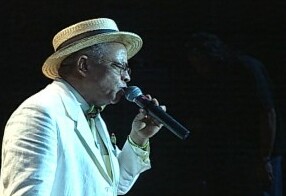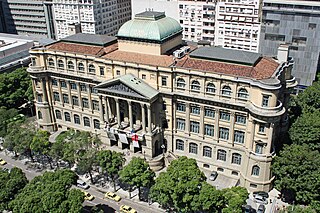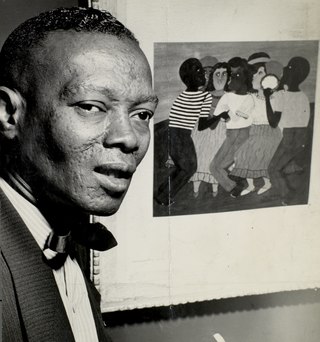Related Research Articles

Samba is a name or prefix used for several rhythmic variants, such as samba urbano carioca, samba de roda, recognized as part of the Intangible Cultural Heritage of Humanity by UNESCO, amongst many other forms of samba, mostly originated in the Rio de Janeiro and Bahia states.

The music of Brazil encompasses various regional musical styles influenced by European, American, African and Amerindian forms. Brazilian music developed some unique and original styles such as forró, repente, coco de roda, axé, sertanejo, samba, bossa nova, MPB, gaucho music, pagode, tropicália, choro, maracatu, embolada, frevo, brega, modinha and Brazilian versions of foreign musical styles, such as rock, pop music, soul, hip-hop, disco music, country music, ambient, industrial and psychedelic music, rap, classical music, fado, and gospel.
Bossa nova is a relaxed style of samba developed in the late 1950s and early 1960s in Rio de Janeiro, Brazil. It is mainly characterized by a "different beat" that altered the harmonies with the introduction of unconventional chords and an innovative syncopation of traditional samba from a single rhythmic division. The "bossa nova beat" is characteristic of a samba style and not of an autonomous genre. The bossa nova wave became popular around the world; this increased popularity helped to renew samba and contributed to the modernization of Brazilian music in general.

The culture of Brazil has been shaped by the amalgamation of diverse indigenous cultures, and the cultural fusion that took place among Indigenous communities, Portuguese colonizers, and Africans, primarily during the Brazilian colonial period. In the late 19th and early 20th centuries, Brazil received a significant number of immigrants, primarily of Portuguese, Italian and Spanish origin, which along with smaller numbers of Germans, Austrians, Arabs, Japanese, Poles, Ukrainians, Russians, Greeks, Chinese, and Koreans gave a relevant contribution to the formation of regional cultures in Brazil, and thus contributed to its current existence as a plural and racially diverse society.
Samba-enredo, also known as samba de enredo, is a sub-genre of modern samba made specifically by a samba school for the festivities of Brazilian Carnival. It is a samba style that consists of a lyric and a melody created from a summary of the theme chosen as the plot of a samba school.

Nei Braz Lopes is a Brazilian singer, composer, lawyer, writer and historian, specializing in Afro-Brazilian studies.

Agostinho dos Santos was a Brazilian singer and composer of bossa nova, MPB and rock and roll, active from the early 1950s until his premature death in the crash of Varig Flight 820 in 1973, at the age of 41.
Mário Sousa Marques Filho, better known as Noite Ilustrada was a Brazilian singer-songwriter and guitarist.

Events in the year 1948 in Brazil.

Chôros No. 2 is a duet for flute and clarinet written in 1924 by the Brazilian composer Heitor Villa-Lobos. It is part of a series of fourteen numbered compositions collectively titled Chôros, ranging from solos for guitar and for piano up to works scored for soloist or chorus with orchestra or multiple orchestras. and in duration up to over an hour. Chôros No. 2 is the shortest in the series, a performance lasting only about two-and-a-half minutes.

Chôros No. 7, subtitled "Settimino" (Septet), is an instrumental septet written in 1924 by the Brazilian composer Heitor Villa-Lobos. It is part of a series of fourteen numbered compositions collectively titled Chôros, ranging from solos for guitar and for piano up to works scored for soloist or chorus with orchestra or multiple orchestras, and in duration up to over an hour. Chôros No. 7 is of modest length, a performance lasting about eight-and-a-half minutes.

Chôros No. 6 is an orchestral work written between 1925 and 1942 by the Brazilian composer Heitor Villa-Lobos. It is part of a series of fourteen numbered compositions collectively titled Chôros, ranging from solos for guitar and for piano up to works scored for soloist or chorus with orchestra or multiple orchestras, and in duration up to over an hour. Chôros No. 6 is one of the longer compositions in the series, lasting about 25 minutes in performance.

The history of the book in Brazil focuses on the development of the access to publishing resources and acquisition of the book in the country, covering a period extending from the beginning of the editorial activity during colonization to today's publishing market, including the history of publishing and bookstores that allowed the modern accessibility to the book.

Tia Ciata, born Hilária Batista de Almeida (1854–1924) was a Brazilian mãe-de-santo of Candomblé, and an influential figure in the development of samba. She was born in Santo Amaro, Bahia, and initiated in Candomblé in Salvador by Bangboshe Obitikô. She was a devotee of deity Oshun and became the iyakekerê, or second most important leader, in the terreiro of João Alabá in Rio de Janeiro. "Ciata", the name by which she is now known, is a variant on the Arabic name Aycha; it was a common feminine name among the Muslim community from Portuguese Guinea that formerly resided in Rio de Janeiro.

Heitor dos Prazeres was a Brazilian composer, singer and painter. He was a pioneer samba composer and participated in the first samba schools in Brazil. Later in life he became known by his paintings.
Samba-jazz or jazz samba is an instrumental subgenre of samba that emerged in the bossa nova ambit in the late 1950s and early 1960s in Brazil.
Samba de breque is a subgenre of samba that emerged in Rio de Janeiro between the late 1930s and early 1940s.
Aníbal Augusto Sardinha, known by his professional name, Garoto, was a Brazilian composer and performer on an array of plucked string instruments including the guitar, tenor guitar, 7-string guitar, banjo, cavaco, cavaquinho, and the bandolim. He was also a singer in several of the ensembles in which he performed. An important performer and composer of Brazilian choro, his compositions, influenced by American jazz, anticipated the development of bossa nova. Garoto performed and collaborated with many important musicians, including guitarists Paraguassú, Aimoré, Serelepe, Armando Neves (Armandinho) and Laurindo Almeida, as well as Carmen Miranda and Radamés Gnattali. He also recorded on several labels, including Parlophone (Brazil), Odeon, Continental, and RCA-Victor, and performed on the radio for Rádio Educadora Paulista, Rádio Cosmos, Rádio Cruzeiro do Sul, Rádio Record, Rádio Mayrink Veiga, Rádio Tupi, and Rádio Nacional.
Katinguelê is a Brazilian pagode and samba group, formed in São Paulo in the first half of the 1980s. They are most well known for their romantic pagode songs as the subgenre began to explode in the 1980s and 1990s.
Osvaldo Caetano Vasques, better known by his artistic name Baiaco (1913–1935), was a Brazilian actor, composer, and samba musician.
References
- 1 2 Lopes & Simas 2015, p. 267.
- 1 2 Marcondes 1977, p. 684.
- ↑ Brasil Silva 2008, p. 123.
- 1 2 Lopes 2020, p. 114.